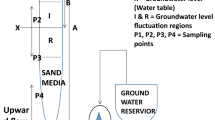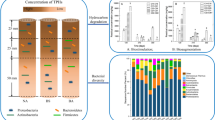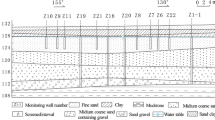Abstract
Groundwater contamination caused by petroleum hydrocarbon (PHC) spills mostly from oil industry is a major environmental concern worldwide. However, infiltration into groundwater is decreasing due to the natural attenuation processes of PHCs in vadose zone, which acts as a safeguard of invaluable groundwater resource against contamination. This study was conducted to determine the retardation capacity of vadose zone and its influence factors based on investigations of a petroleum-contaminated site in NE China. Column leaching experiments in homogeneous and heterogeneous soils were utilized to simulate the actual infiltration process, which aimed to understand the variation of PHC compounds in vadose zone and to examine the effects of soil and water properties on the diversification of the compounds by using gas chromatography–mass spectrometry (GC–MS). The results showed that adsorption and biodegradation are dominant processes and 84 %, 76 %, and 66 % of the organic contaminants were entrapped in fine, medium, and coarse sands, respectively. This was mainly caused by the adsorption coefficient (K d ), which was linked with the soil properties; more specifically, smaller soil aggregates mean a higher K d value and such discrimination also exists among petroleum compounds. Real-time polymerase chain reaction (RT-PCR) and culture-based methods were applied to identify the degrading microorganisms. Results demonstrate that these microorganisms could degrade compounds such as chainalkanes (ChA), cycloalkanes (CyA), and aromatic (Ars) into asphaltenes (Asp). The microorganism population increased with biodegradation products and the consequence of biodegrading capacity was (from high to low): ChA, CyA, and Ars; chemical analyses in the heterogeneous soil experiment indicated that concentration of the biodegradation products in leachate was negatively correlated to dissolved oxygen (DO) as a consumption of oxidants but positively correlated to electrical conductivity (EC) and pH of water. Enzyme activities and microorganism population of soil were positively correlated to concentration of biodegradation products.









Similar content being viewed by others
References
Alejandro, R. G., Maria, A. C., & Marcela, F. (2006). Bioremediation of crude oil polluted seawater by a hydrocarbon-degrading bacterial strain immobilized on chitin and chitosan flakes. International Biodeterioration & Biodegradation, 57(4), 222–228.
Antizar-Ladislao, B., Lopez-Real, J. M., & Bech, A. J. (2004). Bioremediation of polycyclic aromatic hydrocarbon (PAH)-contaminated waste using composting approaches. Critical Reviews in Environmental Science and Technology, 34, 249–289.
Atlas, R. M., & Hazen, T. C. (2011). Oil biodegradation and bioremediation: a tale of the two worst spills in U.S. history. Environmental Science and Technology, 45, 6709–6715.
Berkowitz, B., Sillman, E. S., & Dunn, A. D. (2004). Impact of the capillary fringe on local flow, chemical migration, and microbiology. Vadose Zone Journal, 3, 534–548.
Boehm, P. D., Page, D. S., Brown, J. S., Neff, J. M., Bragg, J. R., & Atlas, R. W. (2008). Distribution and weathering of crude oil residues on shorelines 18 years after the Exxon Valdez spill. Environmental Science and Technology, 42, 9210–9216.
Canadian Council of Ministers of the Environment (CCME). (2000). Canada-wide standards for petroleum hydrocarbons (PHC) in soil: scientific rationale. Supporting technical document. Winnipeg: Canadian Council of Ministers of the Environment.
Chapelle, F. H., Bradley, P. M., & Lovely, D. R. (2002). Rapid evolution of redox processes in a petroleum hydrocarbon-contaminated aquifer. Ground Water, 40(4), 353–360.
Chesnaux, R. (2011). Analytical closed-form solution for assessing pumping cycles, times, and costs required for NAPL remediation. Environmental Geology, 55, 1381–1388.
Dickson, E. M., Riggio, M. P., & Macpherson, L. (2005). A novel species-specific PCR assay for identifying Lactobacillus frementum. Journal of Medical Microbiology, 54, 299–303.
Enell, A., Reichenberg, F., Warlvinge, P., & Ewald, G. (2004). A column method for determination of leaching of polycyclic aromatic hydrocarbons from aged contaminated soil. Chemosphere, 54, 707–715.
Fan, W., Yang, Y. S., Du, X. Q., Lu, Y., & Yang, M. X. (2011). Finger-printing biodegradation of petroleum contamination in shallow groundwater and soil system using hydro-bio-geochemical markers and modeling support. Water, Air, and Soil Pollution, 220, 253–263.
Farhadian, M., Vachelard, C., Duchez, D., & Larroche, C. (2008). In situ bioremediation of monoaromatic pollutants in groundwater: a review. Bioresource Technology, 99, 5296–5308.
Gianfreda, L., Rao, M. A., Piotrowska, A., et al. (2005). Soil enzyme activities as affected by anthropogenic alterations: Intensive agricultural practices and organic pollution. Science of the Total Environment, 341, 265–279.
Jia, Y., Yin, H., & Peng, H. (2007). Petroleum. Degeneration strain screening, preliminary appraisal and characteristics. Jinan University Journal: Natural Sciences Version, 28(3), 296–301.
Kao, C. M., & Wang, C. C. (2000). Control of BTEX migration by intrinsic bioremediation at a gasoline spill site. Water Research, 34(13), 3413–3423.
Kujawinski, E. B., Soule, M., Valentine, D. L., Boysen, A. K., Longnecker, K., & Redmond, M. C. (2011). Fate of dispersants associated with the Deepwater Horizon oil spill. Environmental Science and Technology, 45, 1298–1306.
Lei, Y. D., Yang, Y. S., Du, X. Q., & Cao, Y. Q. (2011). Biodegradation of petroleum hydrocarbon by indigenous microorganisms isolated from an oil contaminated groundwater site. Water Resource and Environmental Protection, 1, 354–357.
Li, Z. G., Luo, Y. M., & Teng, Y. (2008). Soil and environment microorganism methodology. Science Book Concern, 3, 395–397.
Li, M. H., Wang, T. H., & Teng, S. P. (2009). Experimental and numerical investigations of effect of column length on retardation factor determination: a case study of cesium transport in crushed granite. Journal of Hazardous Materials, 162, 530–535.
Lovely, D. R. (2003). Cleaning up with genomics: applying molecular biology to bioremediation. Nature Review: Microbiology, 1, 35–44.
Lu, Y., Yang, Y. S., Du, X., & Fan, W. (2013). Insight into hydro-chemo-biological processes in petroleum contaminated groundwater by integrated modelling, hydrochemical and 16S rDNA PCR-DGGE microbial techniques. Hydrologic Processes, in press.
Marin, J. A., Hernandez, T., & Garcia, C. (2005). Bioremediation of oil refinery sludge by landfarming in semiarid conditions: influence on soil microbial activity. Environmental Research, 98, 185–195.
Mohajeri, L., Aziz, H. A., Isa, M. H., et al. (2010). Ex-situ bioremediation of crude oil in soil, a comparative kinetic analysis. Bulletin of Environmental Contamination and Toxicology, 85, 54–58.
Pasteris, G., Werner, D., Kaufmann, K., & Hohener, P. (2002). Vapor phase transport and biodegradation of volatile fuel compounds in the unsaturated zone: a large scale lysimeter experiment. Environmental Science and Technology, 36, 30–39.
Persson, Y., Hemstrom, K., Oberg, L., Tysklind, M., & Enell, A. (2008). Use of a column leaching test to study the mobility of chlorinated HOCs from a contaminated soil and the distribution of compounds between soluble and colloid phases. Chemosphere, 71, 1035–1042.
Porro, I., Newman, M. E., & Dunnivant, E. M. (2000). Comparison of batch and column methods for determining strontium distribution coefficients for unsaturated transport in basalt. Environmental Science and Technology, 34, 1679–1686.
Rivett, M. O., Wealthall, G. P., Dearden, R. A., & McAlary, T. A. (2011). Review of unsaturated-zone transport and attenuation of volatile organic compound (VOC) plumes leached from shallow source zones. Journal of Contaminant Hydrology, 123, 130–156.
Scow, K. M., & Hicks, K. A. (2005). Natural attenuation and enhanced bioremediation of organic contaminants in groundwater. Current Opinion in Biotechnology, 16, 246–253.
Souza, D. A., Chinalia, F. A., Foresti, E., & Zaiat, M. (2009). Bioremediation of gasoline-contaminated groundwater in a pilot-scale packed-bed anaerobic reactor. International Biodeterioration & Biodegradation, 63, 747–751.
Speight, J. (1998). Petroleum chemistry and refining. Washington: Taylor & Francis.
Sylvia, D. M., Fuhrmann, J. J., Hartel, P. G., & Zuberer, D. A. (1999). Principles and applications of soil microbiology. Upper Saddle River: Prentice-Hall.
Tang, J. C., Lu, X. Q., Sun, Q., & Zhu, W. Y. (2012). Aging effect of petroleum hydrocarbons in soil under different attenuation conditions. Agriculture, Ecosystems and Environment, 149, 109–117.
Vasconcellos, S. P., Dellagnezze, B. M., et al. (2011). The potential for hydrocarbon biodegradation and production of extracellular polymeric substances by aerobic bacteria isolated from a Brazilian petroleum reservoir. World Journal of Microbiology and Biotechnology, 27, 1513–1518.
Wealthall, G. P., Rivett, M. O., Dearden, R. A. (2010). Transport and attenuation of dissolved-phase volatile organic compounds (VOCs) in the unsaturated zone. British Geological Survey. Groundwater Pollution Programme. Internal Report IR/09/0.7.89 pp
Wu, Y., Luo, Y., Zou, D., Ni, J., Liu, W., Teng, Y., et al. (2008). Bioremediation of polycyclic aromatic hydrocarbons contaminated soil with Monilinia sp; degradation and microbial community analysis. Biodegradation, 19, 247–257.
Acknowledgments
This work was financially supported by the National High Technology Research and Development Program of China (863 Program, No. 2007AA06Z343) and the National Natural Science Foundation of China (Grant Nos. 41272255 and 40902068).
Author information
Authors and Affiliations
Corresponding authors
Rights and permissions
About this article
Cite this article
Yang, M., Yang, Y.S., Du, X. et al. Fate and Transport of Petroleum Hydrocarbons in Vadose Zone: Compound-specific Natural Attenuation. Water Air Soil Pollut 224, 1439 (2013). https://doi.org/10.1007/s11270-013-1439-y
Received:
Accepted:
Published:
DOI: https://doi.org/10.1007/s11270-013-1439-y




